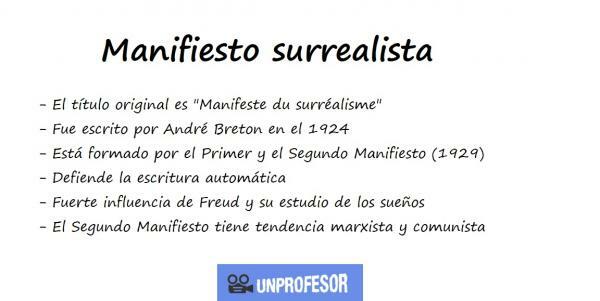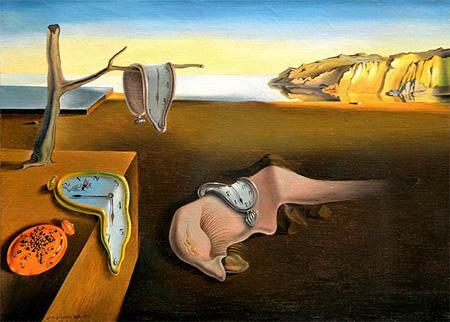SURREALIST Manifesto: First and Second

With the artistic vanguards that appeared in the early twentieth century were many movements that emerged among creators of the time. One of the most important and prominent is Surrealism, an artistic manifestation whose father is the French André Breton and in which it was intended to access the unconscious to create an art that was not subject to either reason or logic. Many artists followed the trail marked by Breton, including painters such as Salvador Dalí, authors such as Vicente Aleixandre and Tristan Tzara.
The aesthetics of this current was predetermined in the André Breton's Surrealist Manifesto, a writing in which the premises on which the artistic works linked to said movement should be created were gathered. In this lesson from a TEACHER we are going to offer a resume of this manifesto of Surrealism so that you know better the ideological base of the current and its most basic characteristics.
Index
- Summary of André Bretón's Surrealist Manifesto
- The second Surrealist Manifesto
- Most outstanding surrealist artists
Summary of André Bretón's Surrealist Manifesto.
We started this lesson on the Surrealist Manifesto to talk about the first of the texts that appeared written by André Bretón. The original name of the text was Manifeste du surréalisme and the October 15, 1924, that is, at the height of the artistic avant-gardes of the 20th century. This text was written as a prologue to a book but its importance was such that it ended up becoming a manifesto in itself. In fact, Breton at the age of five wrote a second manifesto in which he detailed more concisely some aspects that had appeared in the first text.
It is important to indicate that the Surrealist Manifesto that we can read today is the union of both texts, a task that was carried out carried out during the sixties by the hand of the most important publishing houses of the moment to gather the entire ideological basis surrealism movement.
Surrealism was a movement that had a lots of contradictions and this caused that many followers of the movement began to disassociate themselves from it when they saw the difficulties of carrying out this artistic trend. The publication of the first Surrealist Manifesto made the group truncate even more and that there was a break among the followers of the movement; with the second manifest the situation was further aggravated because Breton endowed his manifesto with a very clear political content and positioned in favor of Marxism.
In the first manifesto, André Breton defines that Surrealism is:
"Pure psychic automatism by means of which an attempt is made to express verbally, in writing or in any other way, the real functioning of thought. It is a dictation of thought, without the regulatory intervention of reason, oblivious to any aesthetic or moral concern. "
Characteristics of the first Surrealist Manifesto
Next, we will discover a summary of the more interesting ideas that appear in this first text. They are as follows:
- Automatic writing: It is the method that Breton presents to be able to reach the unconscious and create a literary work free of mental control.
- The importance of imagesAlthough the movement emerged as a literary art, the truth is that in the Breton manifesto it affects the importance that images take since Surrealism is a movement designed to unite the dream with the Arts.
- Avoid reflection: we must put aside reasoning and reflection so that the unconscious comes to the fore during artistic creation.
- Pure thinking: what you want to find with this artistic method is to access pure thought, original thought that is not altered by the mind or reason.
- Influence of Freud: The manifesto also talks about the investigations into the subconscious carried out by Sigmund Freud and, specifically, about the meaning of dreams.
In this first text there are no criticisms of the policy nor to public figures; Breton focuses above all on defining the movement and laying the foundations for artistic creation. The only existing criticism in the manifesto is first made of the artistic world, above all, to the literature and the boredom produced by the creation of the time is denounced due to the lack of originality.
The first manifesto was composed by artists of a Freudian style, among which we highlight Miró, Aragon or Éluard; Importantly, Miró was expelled from the movement years later when Breton turned the movement around and joined Marxism.

Image: Slideshare
The second Surrealist Manifesto.
As we have already commented, the Surrealist Manifesto in its entirety is contemplated with the first text that appeared in 1924 but, also, with the second manifesto that appeared in December 1929. Here, Breton gave a political turn to the artistic current and aligned her to Marxism, a fact that caused many surrealist followers and artists to end up leave the group.
This second manifesto appeared in the magazine "La Révolution Surréaliste" under the title of Second Manifeste du surréalisme written, also, by André Breton. The main difference between the first text and the second is that it has a political and controversial content. The political turn of Surrealism began around 1925 when texts appeared that criticized entities such as the Catholic Church, wars, etc.
The leadership of the movement was Stalinist and tended to support communism and to parties of this nature; This ended up affecting the group of creators since politically they were not aligned under the same perspective; in fact, some of the Surrealist members wanted to join the French Communist Party as militants.
All this controversy is well defined in this second Surrealist Manifesto in which Breton is in charge of criticize members of the movement who are not fighting for the Marxist revolution and who are not in favor of the communism. He declares them as "not pure" surrealists and dedicates the text to explain why the movement has become politicized with the social revolution and communism. He takes advantage of the document to explain, also, the causes of the expulsion of some first generation surrealist members.
Years later, the PFrench Communist Party ended by drive out surrealists as is the case with André Breton himself, but also with Éluard or Crével. This also further unraveled the followers of the movement and some of them follow the party while others follow Breton, an artist who is beginning to have a Trotskyist ideology.
As you can see, the second Surrealist Manifesto was a controversial text that caused the definitive breakdown of this movement.

Image: Slideserve
Most outstanding surrealist artists.
We end this summary of the Surrealist Manifesto by reviewing some surrealist artists who marked the history of our arts. And it is that, despite the fact that over the years the movement was breaking down, the truth is that it has left us with impressive works and with artists who totally broke with the norm and who entered the confines of their imagination and mind.
Surrealist literature
The Surrealism movement appeared in the field of literature and, later, it was extrapolated to other arts. For this reason, there are authors of Surrealism that are very outstanding and that they have left us very interesting works. Names like the French Tristan Tzara, Paul Éluard and René Char they are the most prominent; in Spain we have Vicente Aleixandre who is considered the most prominent Spanish surrealist author.
Surreal painters
In the field of painting, Surrealism also had a great trajectory. In fact, some of the great works of the movement are found in this discipline with such prominent painters as the well-known Salvador Dalí, Miró, René Magritte, Giorgio de Chirico, Leonora Carrington, etcetera.
Surreal artists
We must also talk about other very prominent surrealist artists who are part of other disciplines. It is the case of the film director Luis Bunuel that with his "An Andalusian Dog" he got fully into the movement. Max ernst he is also one of the most prominent artists although, over the years, he ended up associating himself with Dadaism.

If you want to read more articles similar to Surrealist Manifesto: summary, we recommend that you enter our category of Reading.

![Romance of the black penalty of LORCA: analysis and meaning [RESUMEN!]](/f/92266c446212661af2d7290be52d30ba.jpg?width=300&height=200)

![Fireflies by Ana María MATUTE: main and secondary characters [summary!]](/f/3bafca6c4373d19287dc9b9b2cf56503.jpg?width=300&height=200)